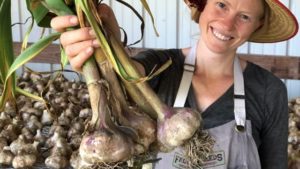We love to share what we love... and we love garlic and shallots! You'll find gorgeous seed garlic & shallots listed here every late Summer/early Fall. And don't forget the fertility... our Organic Garlic and Shallot Fertilizer has specially blended diverse amendments to feed both our soil and our alliums, and in turn, us!
Transcript: Do I have some exciting news; we just harvested our first garlic of the season. It is this glorious soft softneck and artichoke type called Regatusso. And softnecks in general — Oh man, they mature way faster generally than hardnecks, especially here in short seasons, and Regatusso indeed is off to the races.
And I still have a few of these of the tops that we just chopped off. And you can see half of the leaves are brown and dry, take a look at how brittle that is. As opposed to the nutrient deficiencies, which would just be at the top and at the tips, and would be more yellow. And so here’s the thing, we treat our softnecks totally differently than our hardnecks. And I’ll share it all with you. And we when we harvest our softnecks, because they don’t have that hard, really solid stock in the middle, take a look at what they have. It’s all of these tissues, all of the leaf wrappers. And perhaps you can almost see it glisten. It’s super moist. And so if we let those stalks stay on the garlic and just dried them even with our tons of airflow– we have six fans, you can see the fans behind me, we have six different fans setup spread across these screen tables. But they still wouldn’t dry down in time, they would more likely mold.
And so we go ahead and snip them off. So that way all of that air can be moving, drying down those tissues. And we also go ahead and we clip the roots right now. Though, you don’t technically have to, I like to only because they’re a little more soft, a little more pliable. And that way, we’re just doing it a little more streamline. If we dry them down, then they get more tough, more leathery. And if you have great super sharp snips, they’re just gonna chop right off, it doesn’t make a huge difference. But I find it’s just easier for us to streamline it and they cut that much more quickly.
So yeah, take a look at this head. I wanted to show you as well. So here’s the inside as another general rule between hard necks and soft next, a hard neck variety, I think Music is perhaps the most popular. And there’s that hard neck in the middle, right, and there’s five, six cloves around it. And a soft neck doesn’t have that hard central stalk. And it has all of these different rings of concentric cloves. So there’s way more than five, six. Sometimes there’s three if not four times that many cloves. And so you can see on the outside of this Regatusso. So there are these large gorgeous cloves on the outside with concentric rings of smaller clothes in the middle. And the thing I love about Regatusso is that even the cloves in the very center are still way big enough to easily justify the time processing in the kitchen. Often, a lot of the silver skin soft neck types that you’ll find at the grocery store, they’re just little slivers in the center and I always feel so bad not using them, but they’re just kind of annoying. So I love Regatusso, for being a softneck with all of those different cloves, but each one being sizable enough. As soon as I stop this video, I’m going to turn the fans back on. And very importantly as well, we’re in a shed where we get lots of nice airflow. It’s open ended on one side, but there’s it’s very, it’s very dark there in the shade all day long, never in direct sunlight. And that’s super important. When you’re curing garlic you want it to be relatively warm. 80 to 85 is perfect, but not too hot. And definitely out of the way of direct sun, and tons of airflow. Especially with the softnecks (we never have any issues with our hardnecks, they dry down like a breeze) but with the soft necks, all of those tissues can really, they’re so tricky. And so I’ll come in and every few days I’ll be evaluating them, I’ll be puckering them and making sure that it’s getting papery and not squishy in the middle.
And they’ll be here for at least a week, maybe even two weeks drying here on these racks with the fans going full bore the entire time. And that way they’ll be storing all season long. And throughout the winter. One of the nice thing about softnecks as opposed to hardnecks they do generally have a longer storage life, then a hardneck variety. Of course, different varieties have different stories. So there’s definitely shades of gray and everything in between. But we were still eating Regatusso in early May this year. So that all attributes to how will we cure it right now in July. So it’s Friday the 13th friends, wish me luck. I wish you luck as well. And if you have questions, of course I’m here for you.


